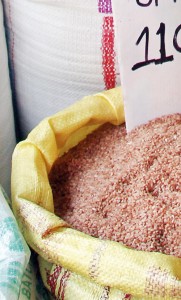Sunday Times 2
What’s cooking: US firm in alleged biopiracy of our ‘Rathu Kekulu’
Every year, usually in February but sometimes in March, the celebration of Mardi Gras (Carnival) reaches its crescendo. Especially popular in the Americas, huge Mardi Gras celebrations take place every year in places ranging from Brazil to Colombia, Trinidad, Mexico, and the US.
The largest Mardi Gras in the United States of America is in New Orleans, Louisiana where, since 1872, the official colours have been purple, gold, and green. And for more than 120 years, following an 1892 decision by organisers, purple has officially symbolised justice at the Louisiana Mardi Gras, which is widely known for its charming and quirky local traditions.

Going Purple: Mardi Gras at New Orleans
Each year when Carnival comes, the city of New Orleans fills with people quite likely to be wearing purple. Party goers don purple masks, exchange purple beads, toss purple confetti, quaff purple drinks, taste purple sweets and, thanks to farmers a half a world away, now have the chance to eat purple rice.
The fact that purple symbolises justice at Mardi Gras will surely seem ironic to Sri Lankan rice farmers, whose dark colored grains have given rise to a “new” purple rice grown and sold in Louisiana, and which has been placed under intellectual property claim, incongruously, with a Spanish name.
Rush Rice Products of Baton Rouge, Louisiana, a small but growing company, markets the purple rice, variety name Blanca Isabel, under plant breeder’s rights protection. It especially targets fans of Louisiana State University, which adopted the Mardi Gras colour signifying justice for the uniforms of its sporting teams, named the Tigers.
In addition to capitalising on the regional popularity of the colour purple, Rush Rice Products touts Blanca Isabel as offering a variety of health benefits, all related to its pigmentation, including the claim that it can help prevent “a number of long-term illnesses such as heart disease, cancer, and an eye disorder called macular degeneration.”
Dubiously asserting that Blanca Isabel’s health benefits are “unique” – perhaps it is true in Louisiana but certainly not more widely in other societies – the company claims that Blanca Isabel “is unique in that it has health compounds that are not reported from any other rice compounds in the world. Compounds that are found in green tea where there are known to be health compounds, and also resveratrol which is health compound found in red wine and red grapes and no other rice has had this reported.”
Of course, in some areas of the world, especially parts of rural Asia, people are accustomed to rice varieties with wide variation in colour and other traits. Diverse rice varieties, with different uses according to local tastes, grain characteristics, culture and religion, have been developed by and kept in the field by generations of small farmers.
In other regions, including rice farming areas in Louisiana, long grain varieties milled bright white, indistinguishable from one another by the consumer, are typically the only locally-produced rice to be found. Unlike areas where diverse rice types have been cultivated for many centuries, in these areas of industrial production, rice is typically perceived as a source of carbohydrates with few other intrinsic health benefits.
Thus, a coloured rice in Louisiana has significant potential market appeal both for the local novelty of its colour and associated health claims.

From Rathu Kekulu to Hitan Kitan: Lankan farmers denied intellectual property rights
Milton Rush, a former Louisiana State University (LSU) professor was the breeder of Blanca Isabel. Rush, who passed away in 2013, founded Rush Rice Products and stated in research publications that the variety owes its colour and other characteristics to “Hitan Kitan”, which Rush said is a Sri Lankan farmers’ variety.
Unfortunately, research references on “Hitan Kitan” are extremely thin. Black, red, and other rice types are familiar to many farmers and breeders, but a rice variety named Hitan Kitan appears to be unknown to genebanks and absent from scientific publications, except those linked to Rush himself.
No variety named Hitan Kitan, from Sri Lanka or any other country, is listed in the collection of the International Rice Research Institute (IRRI) in the Philippines. Nor can it be found in the US national collection. Research articles mentioning Hitan Kitan are very limited and all linked to Rush’s development of “Blanca Isabel”.
The earliest citation for the variety, that referenced the application for plant breeder’s rights, is an obscure 1998 research update that appeared in the annual report of LSU’s rice breeding centre, where Rush was a specialist in plant disease. This report lists Hitan Kitan among a number of varieties used in experiments to identify disease resistance. The article contains no information on where and when Hitan Kitan was collected or how it arrived in Louisiana. In fact, it contains no real information about Hitan Kitan at all.
An LSU PhD dissertation by one of Rush’s students is similarly unhelpful. Its citation on the origin of Hitan Kitan is a link to general information about rice diversity at IRRI. At another point in the dissertation, Hitan Kitan’s Sri Lankan origin is attributed to a personal communication with Rush.
It is possible that “Hitan Kitan” has another name, used in research and/or genebanks, and that it has been incorrectly or unusually transcribed in Louisiana. With Rush’s death, however, the details may never be known.
The breeding of Blanca Isabel was a straightforward affair. It began with the cross between Hitan Kitan, which may have been a black rice, and Cypress, a local white long grain variety, in 1998 (made for disease resistance research). From there, Rush simply selected plants for purple color, grain length, and height, replanting them and quickly arriving at what would become Blanca Isabel by 2003.
While there is nothing intrinsically wrong with an American company producing and selling coloured rice, particularly if it in fact delivers health benefits, what is troubling in the case of Blanca Isabel is lack of credit and benefit sharing with Sri Lankan farmers as well as the granting of intellectual property rights over a rice variety derived from a source that has not been disclosed and described, and which remains essentially unknown.
In the case of Blanca Isabel, the willingness of the US Plant Variety Protection Office, certainly not alone among its peers in other countries, to grant intellectual property (plant breeder’s rights in this case) over a seed whose salable traits are of an essentially unknown origin has led to biopiracy. Blanca Isabel thereby illustrates the importance of requiring disclosure of origin of genetic resources in plant breeder’s rights applications.
Such disclosure and benefit sharing is how the symbolism of Mardi Gras can be fulfilled, rather than inverted, and justice achieved for the Sri Lankan and other farmers who developed richly coloured and healthy rice varieties.
Courtesy Third World Network -
www.twnnews.net

